|
July 2008
Older workers
Are there more older people in the workplace?
 Between 1977 and 2007, employment of workers 65 and over increased 101 percent, compared to a much smaller increase of 59 percent for total employment (16 and over). The number of employed men 65 and over rose 75 percent, but employment of women 65 and older increased by nearly twice as much, climbing 147 percent. While the number of employed people age 75 and over is relatively small (0.8 percent of the employed in 2007), this group had the most dramatic gain, increasing 172 percent between 1977 and 2007. Between 1977 and 2007, employment of workers 65 and over increased 101 percent, compared to a much smaller increase of 59 percent for total employment (16 and over). The number of employed men 65 and over rose 75 percent, but employment of women 65 and older increased by nearly twice as much, climbing 147 percent. While the number of employed people age 75 and over is relatively small (0.8 percent of the employed in 2007), this group had the most dramatic gain, increasing 172 percent between 1977 and 2007.
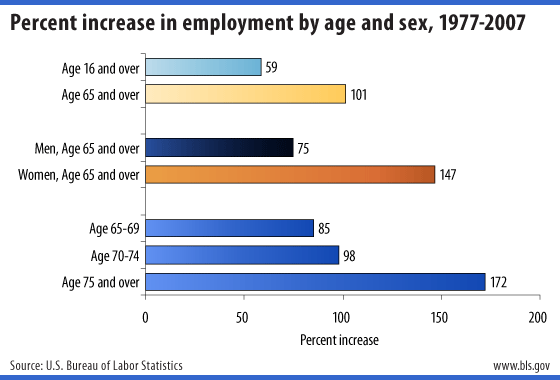
Source: Current Population Survey (CPS) | Chart Data
Does this increase just reflect the aging
of the baby-boom population?
No, because in 2007 the baby-boom generation — those individuals born between 1946 and 1964 — had not yet reached the age of 65.
Between 1977 and 2007, the age 65 and older civilian noninstitutional population — which excludes people in nursing homes — increased by about 60 percent, somewhat faster than the civilian noninstitutional population age 16 and over (46 percent). Yet employment of people 65 and over doubled while employment for everyone 16 and over increased by less than 60 percent. How can employment increase more than the population? A larger share of people 65 and older is staying in or returning to the labor force (which consists of those working or looking for work). The labor force participation rate for older workers has been rising since the late 1990s. This is especially notable because the 65-and-over labor force participation rate had been at historic lows during the 1980s and early 1990s.
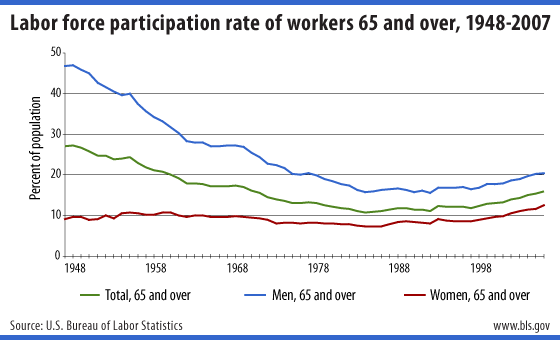
Source: Current Population Survey (CPS) | Chart Data
Are older workers choosing part-time
or full-time employment?
Since the mid-1990s there has been a dramatic shift in the part-time versus full-time status of the older workforce. The ratio of part-time to full-time employment among older workers was relatively steady from 1977 through 1990. Between 1990 and 1995, part-time work among older workers began trending upward with a corresponding decline in full-time employment. But after 1995, that trend began a marked reversal with full-time employment rising sharply. Between 1995 and 2007, the number of older workers on full-time work schedules nearly doubled while the number working part-time rose just 19 percent. As a result, full-timers now account for a majority among older workers: 56 percent in 2007, up from 44 percent in 1995.

Source: Current Population Survey (CPS) | Chart Data
What portion of employed older women are married?
In 1977, about one-third of employed women 65 and older were married, but by 2007, married women accounted for nearly one-half of these workers. Women workers who were widowed, divorced or separated represented 56 percent of employed women 65 and older in 1977; by 2007 their share had fallen to 48 percent. During the same time period, the fraction of older women workers who were never married shrank from about 11 percent to about 6 percent.
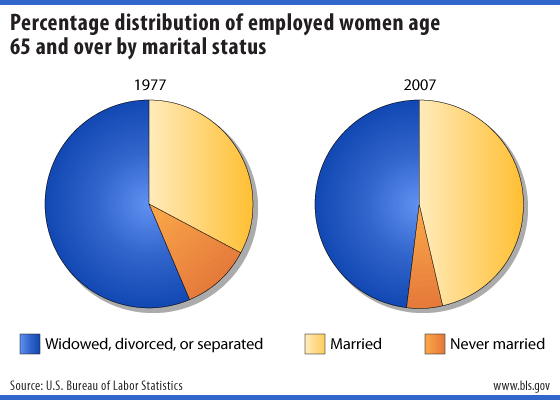
Source: Current Population Survey (CPS) | Chart Data
How do older workers stack up against younger workers in terms of education?
It wasn't that long ago that older and younger workers had very different educational backgrounds. In 1997, 21 percent of employed older workers had less than a high school education compared to only 10 percent of those ages 25-64. By 2007, older workers with less than a high school education accounted for just 13 percent of that group’s employment, compared with 9 percent for younger workers.
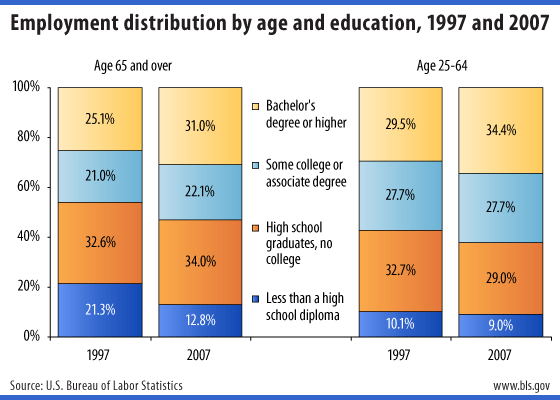
Source: Current Population Survey (CPS) | Chart Data
How do wages of older workers measure up against
wages for all workers?
Earnings of workers 65 and older have long been below those of all workers. In 1979, median weekly earnings for full-time workers age 65 and older were $198 compared to $240 for all full-time employees age 16 and up. In 2007, earnings of older workers were $605 per week, still below the median of $695 for all workers. (All of these earnings amounts are in current dollars.) Over the long term, however, earnings of older workers have risen at a slightly faster pace than the total workforce. In 1979, median earnings of older full-time employees were 83 percent of those ages 16 and up; but, by 2007, that ratio had climbed to 87 percent.
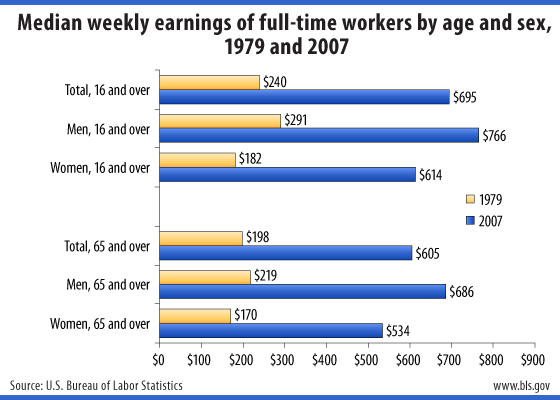
Source: Current Population Survey (CPS) | Chart Data
How does inflation affect older workers?
A number of years ago, the Bureau of Labor Statistics created an experimental consumer price index (CPI) for Americans 62 years of age and older. In this index, items purchased more frequently by the older population, such as medical care, have a higher weight than in the official CPI (which covers a much broader share of the population); items purchased less frequently, such as clothing, have a lower weight. Data from the experimental series show that the annual inflation rate for seniors has been equal to or greater than the inflation rate for all urban consumers in every year since that series began except for 1983 and 2007. However, the yearly differences have been fairly small; over the past 25 years the index for older Americans has risen an average of 3.3 percent each year, as compared to 3.1 percent for the official CPI.
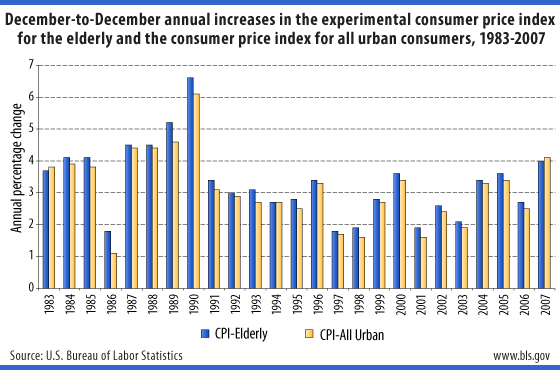
Source: Consumer Price Index (CPI) | Chart Data
How have retirement benefits changed?
Among all workers, participation in defined benefit plans has fallen while participation in defined contribution plans has risen. In defined benefit plans, companies promise to pay workers a specified amount in retirement benefits. In defined contribution plans, companies promise to contribute a specified amount, but make no assurance as to the final payout. Among all workers, there has been a decrease in the percentage covered by defined benefit (“payout”) plans and an increase in the percentage covered by defined contribution (“pay in”) plans. For more and more workers, this means that risk — in terms of steady retirement income — has been transferred from the employer to the eventual retiree.
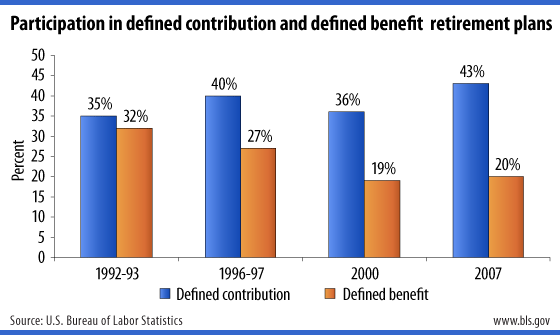
Source: National Compensation Survey - Benefits | Chart Data
Is this graying of the workforce expected to continue?
Definitely. BLS data show that the total labor force is projected to increase by 8.5 percent during the period 2006-2016, but when analyzed by age categories, very different trends emerge. The number of workers in the youngest group, age 16-24, is projected to decline during the period while the number of workers age 25-54 will rise only slightly. In sharp contrast, workers age 55-64 are expected to climb by 36.5 percent. But the most dramatic growth is projected for the two oldest groups. The number of workers between the ages of 65 and 74 and those aged 75 and up are predicted to soar by more than 80 percent. By 2016, workers age 65 and over are expected to account for 6.1 percent of the total labor force, up sharply from their 2006 share of 3.6 percent. (For more data see Civilian labor force by sex, age, race, and Hispanic origin.)
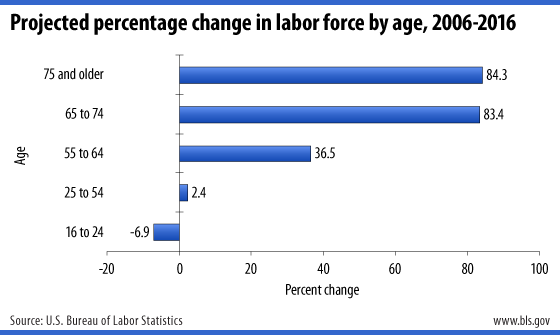
Source: Employment Projections | Chart Data
With the baby-boom generation about to start joining the ranks of those age 65 and over, the graying of the American workforce is only just beginning.
|